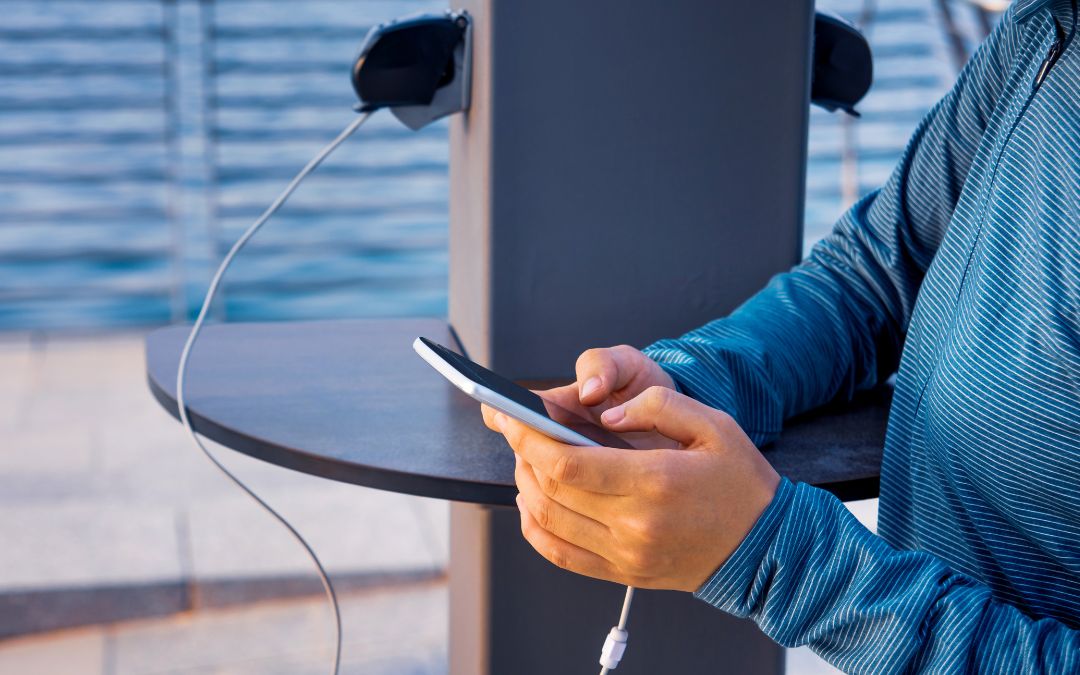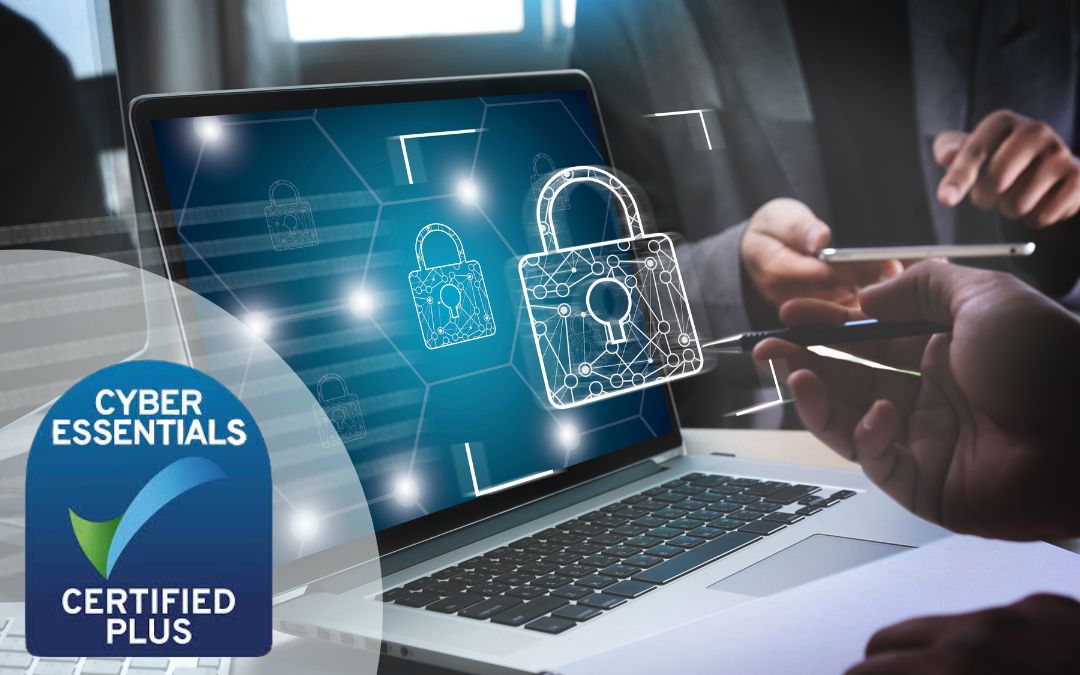
Today’s blog is all about how to avoid hackers at public charging points.
Ever wondered if it’s safe to plug your phone or laptop into a charging point at an airport, on a train, or in a coffee shop?
Did you know you could be at risk from dangerous malware and unscrupulous hackers who want to steal your hard-earned money and personal information?
Read on to find out more and crucially, how to avoid hacking over power points known as Juice Jacking.
In our hyper-connected, fast-moving world, smartphones have become an indispensable tool for communication, productivity, and entertainment. As a result, the need to keep our devices powered up and ready for use at all times is more critical than ever. Public charging points have emerged as convenient solutions for recharging our smartphones on the go, providing much-needed power at airports, malls, coffee shops, and other high-traffic locations. This issue becomes even more significant during the summer months when millions of people travel and rely on public charging stations like these to keep their devices charged.
However, with this convenience comes an often-overlooked security risk. Cybercriminals are increasingly targeting public charging points to exploit unsuspecting users, compromising their sensitive data and even gaining unauthorised access to their devices. The potential security risks associated with using public charging points have even caught the attention of major crime prevention organisations, including the FBI, which has issued warnings to the public about these threats. You can read more about the FBI’s advisory here.
In this blog post, drawing on my two decades (and more) of IT expertise, we will delve into the potential hazards of using public charging stations and equip you with practical knowledge to ensure your smartphone remains safe from hackers while charging. By staying informed and following best practices, you can confidently power up your device without compromising your security during the summer holiday season and beyond.
Understanding the Risks
As you plug in your phone to charge at a public charging point, it’s essential to be aware of the potential security risks involved. In the section below, I will outline some key concerns and explain how they could affect your device.
1. Juice Jacking: What is it and how it does it work?
Juice jacking is a cyber-attack where hackers exploit public charging stations to steal data from connected devices or infect them with malware. This is possible because USB cables, which are commonly used for charging, also transfer data. When you plug your phone into a compromised charging station, the attacker can access your device’s information or install malicious software without your knowledge.
Bear in mind that the charging process is not fast, therefore people leave their phones connected for long periods of time, in some cases longer than an hour. This provides an ample amount of time for the attacker to try to break into your device.
2. Malware and data theft possibilities
Malware installed through juice jacking can take various forms, such as keyloggers, ransomware, or spyware. These malicious programs can potentially record your keystrokes, encrypt your data for ransom, or monitor your activities to steal sensitive information like passwords, authentication cookies and banking details. The consequences of such breaches can range from financial loss and identity theft to the exposure of personal data and compromised online accounts.
Real-world examples of public charging station hacks
While juice jacking attacks may not be as widespread as other forms of cybercrime, it has been reported in various locations worldwide. In 2019, the Los Angeles County District Attorney’s Office issued a warning about the risks of using public USB charging stations, citing potential malware infections. There have also been instances where security researchers have demonstrated the feasibility of these attacks at technology conferences, highlighting the ease with which hackers can exploit public charging points to compromise unsuspecting users’ devices.
By understanding these risks and remaining vigilant, you can take steps to ensure your smartphone’s security while using public charging stations. In the following sections, we will provide practical tips and recommendations to help you stay safe while keeping your device charged.
Tips for Staying Safe While Using Public Charging Points
To minimize the risks associated with using public charging points, consider implementing the following precautions and best practices:
1. Carry your own charger and cable
One of the simplest ways to avoid potential security issues is to carry your own charger and cable. By using a power outlet and your charging equipment, you significantly reduce the risk of connecting to a compromised charging station, and this should be your first step. However, in case you don’t have one with you, we have further advice…
2. Use a USB data blocker
A USB data blocker is a small device that you can attach to your charging cable. It allows power to pass through but blocks any data transfer, effectively preventing juice-jacking attempts. These devices are affordable and portable, making them a worthwhile investment for frequent users of public charging points. The idea is this: a USB has four cables, two of which are used for data transfer and another two which are used for charging (a positive and negative cable). As a USB data blocker only connects to the charging cables, there is no way to use it for data transfer of any kind. A quick search on Amazon UK for USB data blockers will bring you a host of affordable devices.
3. Utilize power banks and laptops as an alternative
Power banks are portable battery packs that allow you to charge your devices on the go without relying on public charging points. By investing in a reliable power bank, you can ensure that your device remains charged and secure, even when away from a power outlet. You can either use an external power bank or a case that attaches to your phone and provides you with an additional battery pack. An alternative solution would be to connect your phone to your laptop and recharge it from the laptop battery. If you can connect your laptop to the mains with its charger both of your devices can be charged while staying safe. However, more modern laptops utilise USB C for fast data transfer and charging. In such cases, it is safer to use USB C with your own charger as laptops are vulnerable in the same way as phones when connecting to an untrusted USB connection.
4. Keep your device locked and avoid sensitive activities while charging
While your device is connected to a public charging point, ensure it remains locked. While the device is locked, the data on it is encrypted, thus making it harder for an attacker to access it. Please refrain from engaging in sensitive activities such as online banking, accessing personal email accounts, or entering passwords. This reduces the likelihood of exposing your data to potential threats. However, if for any reason you will get an unexpected and unrequested notification asking you to authorise access to your data, you should always decline.
5. Regularly update your device’s software and security features
Keeping your smartphone’s operating system (OS) and security software up to date is crucial for protecting against malware and other cyber threats. The same applies to all of your apps. Regular updates often include patches for known vulnerabilities, ensuring that your device remains as secure as possible.
6. Disconnect your device or use low-power mode.
Another way to stay secure is to minimize the time you use your device. Sometimes skipping a dose of social media in order to leave your device with a sufficient amount of power for emergencies during travel is a prudent way to stop hackers. Remember, if your phone is not connected to the compromised power socket it cannot be hacked.
Additionally, you can extend your device’s battery life by enabling low-power mode or battery-saver mode while charging. This feature reduces power consumption by limiting background processes, screen brightness, and other non-essential functions. Enabling a low-power mode on your fully charged phone when you are travelling is a good habit. There is much less chance you will run out of power before getting to your destination.
And my final advice on this topic would be if you are not travelling alone you could agree with the other person that only one phone is switched on, while the 2nd person’s phone is off preserving the battery. This way you can get almost anywhere in the world without the need to recharge in unsecured places.
Conclusion
Staying informed and vigilant while using public charging points is crucial to keeping your smartphone and other devices safe from potential cyber threats. By following the tips and recommendations provided in this blog post, you can confidently charge your device without compromising your security.
If you ever find yourself in doubt or worried about using a public charging station, please don’t hesitate to send me a direct message or leave a comment on this blog. Our team is more than happy to lend a helping hand and provide guidance on how to protect your smartphone while charging on the go.
Remember, staying charged and secure is a shared responsibility, and we’re here to support you in every way possible.
I’ll be back with a new blog very soon, but in the meantime, if you need IT support of any kind, please reach out and contact my friendly team of experts. At Operum, we can help with everything from cyber security, cloud computing, and IT compliance to IT infrastructure support, cyber essentials, and more. We love working with our IT support clients and using our IT knowledge and experience to make their lives easier. We take care of the tech stuff so you can focus on what you do best. You can contact us here: Contact Us – Operum.
Sign up below to join the Operum newsletter



